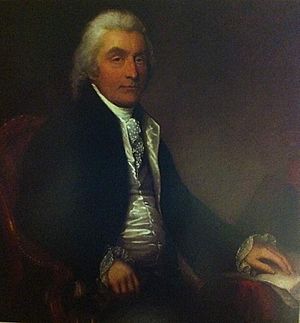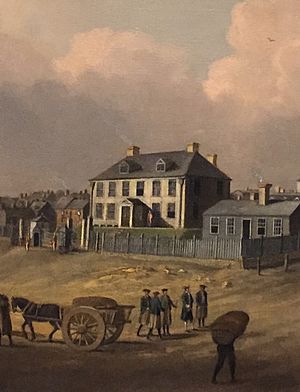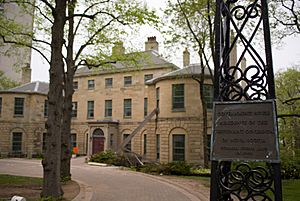Government House (Nova Scotia) facts for kids
Quick facts for kids Government House |
|
|---|---|

Main façade of Government House
|
|
| General information | |
| Architectural style | Adamesque Georgian |
| Town or city | 1451 Barrington Street Halifax, Nova Scotia |
| Country | Canada |
| Coordinates | 44°38′36″N 63°34′17″W / 44.643414°N 63.571293°W |
| Construction started | 1800 |
| Client | The King of the United Kingdom (George III) |
| Owner | The Queen in Right of Nova Scotia (Elizabeth II) |
| Technical details | |
| Structural system | Timber framing and load-bearing masonry |
| Official name: Government House National Historic Site of Canada | |
| Designated: | 1982 |
| Type: | Provincially Registered Property |
| Designated: | 1983 |
| Reference #: | 00PNS0007 |
Government House in Halifax is a very important building. It's the official home for the Lieutenant Governor of Nova Scotia, who represents the King or Queen in Nova Scotia. It's also where the Canadian monarch stays when they visit Halifax. You can find it at 1451 Barrington Street in the middle of the city, surrounded by pretty gardens.
Contents
History of Government House
The building of Government House began in 1800. The governor at the time, Sir John Wentworth, ordered its construction. It was meant to replace an older governor's house. The first stone was laid on September 1, 1800.
The land was first bought for a new government building. However, it was decided to be too far from the city center. So, it became the home for the governor instead. The governor and his family moved into the house in 1805, even though it wasn't fully finished yet.
Royal Visitors to Government House
Many members of the Royal Family have visited Government House. The first royal guest was Prince Edward in 1860, who later became King Edward VII. Other important visitors include:
- Prince Arthur, Duke of Connaught and Strathearn, in 1869. He also served as the Governor General of Canada.
- Prince George (later King George V) in 1883 and 1901.
- Prince Albert in 1913, and again in 1939 as King George VI. He visited with his wife, Queen Elizabeth.
- Queen Elizabeth, the Queen Mother, returned in 1967 for Canada's 100th birthday. She visited again in 1979.
- Princess Elizabeth, Duchess of Edinburgh, in 1951. She returned as Queen Elizabeth II in 1959, 1976, 1994, and 2010.
- Princess Margaret, Countess of Snowdon, in 1958 and 1988.
- Queen Elizabeth II's children: Prince Andrew in 1985 and Prince Edward in 1987.
- Prince Charles, Prince of Wales, in 1983, with Diana, Princess of Wales.
In 1854, a fire started in the attic of the mansion. But the fire was controlled because the building was designed to be fire-safe.
Protecting a Historic Building
Government House is one of Canada's oldest official homes. Because of its history, it was named a National Historic Site of Canada in 1982. The next year, the government of Nova Scotia also listed it as a Provincially Registered Property. This was to recognize its beautiful Georgian architecture and its link to many lieutenant governors and the Canadian monarchy.
The building needed a lot of care. It went through big repairs and updates for three years, finishing in 2008. Queen Elizabeth II officially opened the building again on June 28, 2010. At that time, a new Royal Key was created. It was given to the Queen and then returned to be used by future lieutenant governors. Today, Nova Scotia's Government House is the oldest home for a viceregal representative in North America.
What Government House is Used For
The Queen in Right of Nova Scotia owns Government House. Sometimes, it is open for the public to visit. It's also where members of the Canadian Royal Family and important visitors from other countries are welcomed. They often stay there when they are in Halifax.
Government House is also used for many important events. These include:
- Giving out provincial awards, like inductions into the Order of Nova Scotia.
- Hosting special lunches, dinners, and receptions.
- Holding speeches and important meetings.
It is also where the lieutenant governor performs official duties. For example, they will start an election by "dropping the writs." They also swear in new members of the Executive Council (like government ministers). The lieutenant governor also meets with the premier (the head of the provincial government) at Government House. In 2016, the Lieutenant Governor of Nova Scotia, John James Grant, hosted a meeting for all of Canada's lieutenant governors there.
Architecture and Art of Government House

Government House has a style called Georgian, with some touches of Adam. Parts of the building's design came from a book of house plans published in 1795. This book was by George Richardson, who used to work for famous architects Robert and James Adam.
Many of the building materials came from Nova Scotia. The stone was from places like Antigonish, Bedford Basin, Cape Breton, Lockeport, Lunenburg, and Pictou. Bricks came from Dartmouth, and pine wood from the Annapolis Valley, Cornwallis, and Tatamagouche. Some materials were brought in from other places too. Marble fireplaces were made in London, England.
The inside of the house was designed for both parties and official government work. It has a drawing room, dining room, and ballroom for formal events. There were also rooms for the governor, his family, and their staff. At the time, no other building in Nova Scotia was as well-designed or decorated. Many portraits by the artist Robert Field hang throughout the building.
Images for kids






